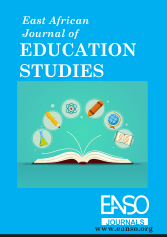Influence of Principals’ Monitoring and Evaluation of Instruction on Students’ Performance: A Case Study of Secondary Education in Londiani Sub-County, Kenya
Abstract
Students’ academic performance in Kenya Certificate of Secondary Education in Londiani Sub-County has been low for the last four years. This has denied many students an opportunity to further their studies and realize their academic dreams. The purpose of this study was to establish the influence of principals’ monitoring and evaluation of instruction on performance of students. The study sought to find out; class teachers’ perceptions on the influence of monitoring and evaluation of instruction on performance of students, students’ perceptions on the influence of monitoring and evaluation of instruction on performance of students among secondary schools in Londiani Sub-County. The study was guided by the Van Bertanlaffy’s general system theory. The study employed mixed methods approach and adopted survey research design. A target population of 20 principals, 55 class teachers and 1080 form four students were targeted for the study from which a sample of 19 principals, 48 class teachers and 284 form four students were drawn. Data was collected from students and class teachers using questionnaires while qualitative data was drawn from principals using an interview schedule. The instruments’ reliability was determined by piloting in 10% percent of the secondary schools, its data analyzed using a reliable Cronbach’s coefficient alpha of 0.76. The validity of the research instruments was established using from expert opinion of the supervisor. Quantitative data was collected, analyzed and presented on tables while qualitative data has been discussed thematically. The study found out that monitoring and evaluation enhances performance for teachers, enables the principal to identify their weakness and strengths thus enhancing their professional development, and enhances provision of insights into the students learning needs thus enabling teachers to develop effective teaching approaches that enhances students’ comprehension and engagement. The study recommends that students are monitored by keeping a record of their academic progress, monitoring class attendance and supervising issuance and crosschecking of assignments given to learners to improve academic performance
Downloads
References
Al-Shareef, S. Y., & Al-Qarni, R. A. (2016). The Effectiveness of Using Teacher-Teacher Wikis in Collaborative Lesson Planning and Its Impact on Teacher's Classroom Performance. English Language Teaching, 9(4), 186-202.
Babatunde, M. M., &Olanrewaju, M. K. (2014). Predictive Influence of Students’ Academic Engagement and Academic Self-Concept on Achievement Motivation among Post Graduate Students in University of Ibadan, Oyo State, Nigeria. International Journal of Science and Research (IJSR), 3(5), 497-503
Bertalanffy, L.V. (1968). General System Theory. Foundations, Development, Applications: George Braziller, Inc. One Park Avenue New York, N.Y.10016
Creswell, J. W. (2009). Research Design: Qualitative, Quantitative and Mixed Methods Approaches. Thousand Oaks, California: Sage Publications.
Cotton, K. (2008). Monitoring student learning in the classroom. Office of Educational Research and Improvement (OERI), U.S. Department of Education
Krejcie, R. V., Morgan, D. W., (1970). “Determining Sample Size for Research Activities”, Educational and Psychological Measurement (Online) (http://www.fns.gov.).
Kruger, A. (2005). Instructional leadership: the impact on the culture of teaching and learning in two. South African Journal of Education, Volume 23 (3), 206 – 211
Kothari, C. R., (2004). Research Methodology: Methods and Techniques.2nd Ed. Reprinted. New Delhi. New Age International (P) Ltd., Publishers
Marzano, R. J., &Toth, M. D. (2014). Teaching with Rigor: A Call for Critical Instructional Shift. Learning Science International. Marzano Center. (Online). Available at; www.marzanocenter.com/files/Teaching-for-Rigor-20140318.pdf. Retrieved on; 3.08.2017.
Mugide, H. (2018). Academic stress, test anxiety and performance among secondary school Students of Mbale progressive secondary school (Doctoral dissertation, Makerere university).
Oso, W. Y., &Onen, D. (2005). A general guide to writing research proposal and report: A handbook for beginning researchers. Kisumu, Kenya: Option Press and Publishers.
Samoei, C. J. (2015). Instructional supervisory role of principals and its influence on students’ academic achievement in public secondary schools in Nandi North District, Nandi County, Kenya (Doctoral dissertation).
Suhariyono, E. (2023). Headmaster As A Change Agent In Realizing The Vision Of A Superior School. Indonesian Journal of Education (INJOE), 3(2), 214-226.
Sullivan, S., &Glanz, J. (2000). Alternative approaches to supervision: Cases from the field. Journal of curriculum and supervision, 15(3), 212-235
UNDP, (2006). Handbook on Monitoring and Evaluation for Results. UN: Millennium Development Goals Report 2006.
UNESCO, (2017). Education for Sustainable Development Goals. United Nation Educational Scientific and Cultural Organization. France: Paris. (Online). Available at; https://unesdoc.org/images/0024/002474/247444e.pdf. Retrieved on; 21.07.2017
Waweru, S. N., Nyagosia, P. O., &Njuguna, F. W. (2013). Factors influencing academic achievement in public secondary schools in Central Kenya: An effective schools’ perspective
Copyright (c) 2024 Millicent Chepkoech, Stephen Tomno Cheboi, PhD

This work is licensed under a Creative Commons Attribution 4.0 International License.




























